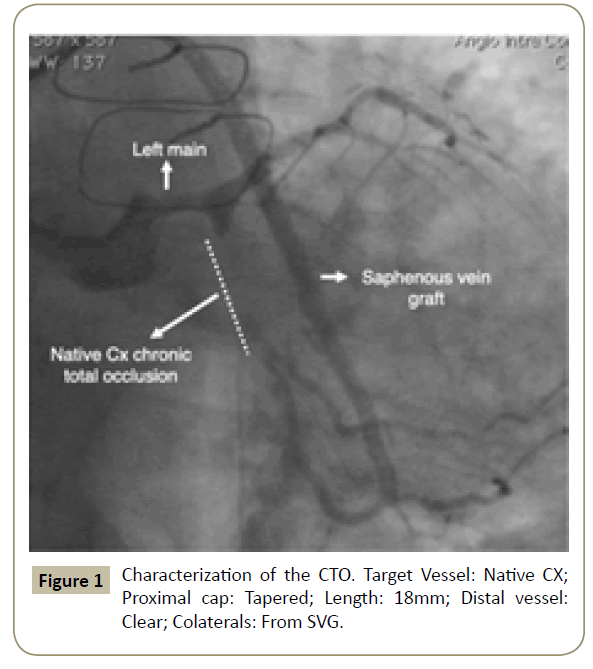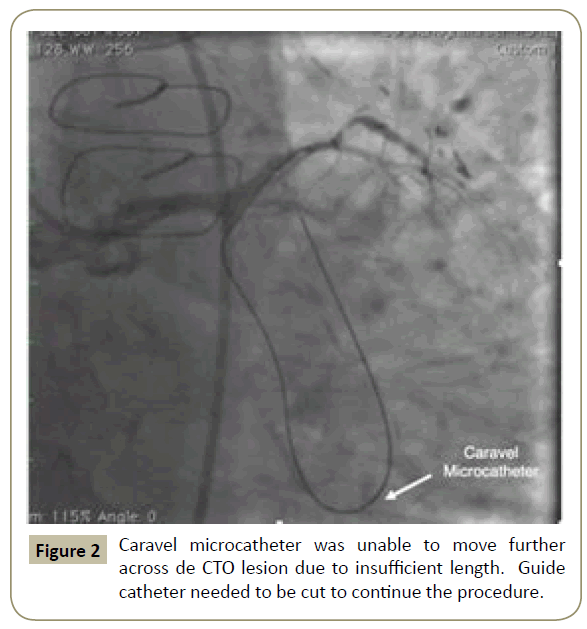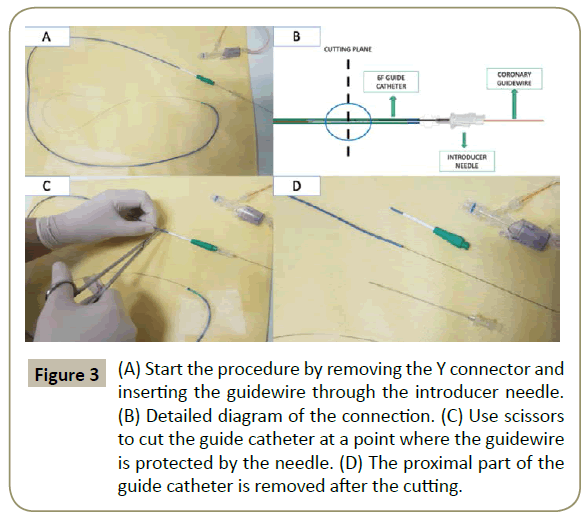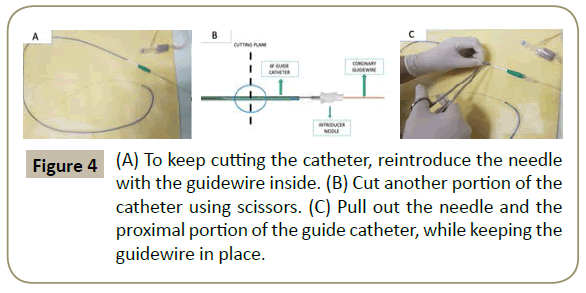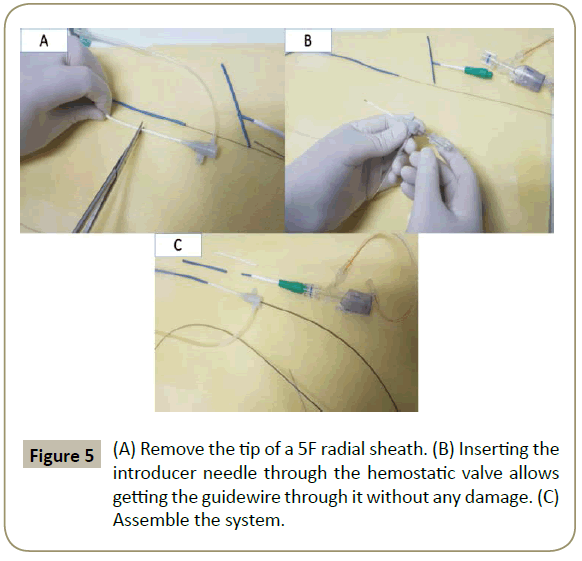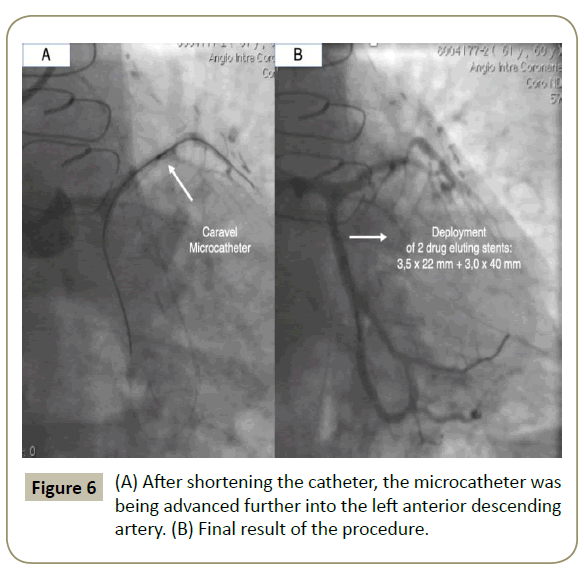Keywords
Percutaneous interventions; Chronic total occlusions
Introduction
A chronic total occlusion (CTO) is defined as the complete
obstruction of a coronary artery, exhibiting TIMI 0 or TIMI 1 flow
for at least 3 months. CTOs are a common finding in almost 15-
25% of the patients with stable angina [1] and they present a
technically challenging scenario. Since its original description in
2006 by the Toyohashi Heart Center [2], the retrograde approach
for CTO PCI has become widespread all over the world with its
utilization steadily increasing to almost 29.9% in 2015 [3] and
success rates close to 85-88% [4].
Despite increasing improvements in the operator`s skills and the
development of specialized material, it`s not always possible
to prepare in advance for the difficulties one might find in the
procedure. During the beginning of the retrograde CTO PCI development, guide catheters were usually shortened before
the procedure and nowadays it is an uncommon situation when
working with the proper material. However, operators might
still found themselves in situations where there is the need for
shortening a guide catheter during a retrograde approach or
even have to do so with the guidewire already across the lesion.
There is a lack of knowledge on how to adequately solve this
issue and very few publications address the technical details to
accomplish it.
We introduce a simple technique to solve this situation without
sacrificing the guidewire position.
Case Presentation
We present the case of a 60-year-old male, with a past medical
history of type 2 Diabetes Mellitus, Hypertension, obesity, and
coronary artery disease. The patient had undergone coronary
artery bypass graft surgery (CABG) in 2005 with a Left internal
mammary artery graft to the left anterior descending artery
(LIMA-LAD), saphenous vein graft to the posterior descending
artery of the right coronary (SVG – PDA RCA) and a saphenous
vein graft to the circumflex artery (SVG-ACx).
He also had a proximal chronic total occlusion (CTO) of the native
circumflex and 2 previous percutaneous coronary interventions
(PCI) to the SVG-Cx with drug-eluting stents (2017-2018). 6
months later, the patient presented with occlusion of SVG-Cx
due to a neoatherosclerotic ruptured plaque. Only plain balloon
angioplasty (POBA) was performed to restore flow through the
SVG and staged revascularization of the native ACx was planned
in the following 48 hours. The first attempt to recanalize the CTO
with an antegrade approach was unsuccessful due to a proximal
dissection so the patient was referred to our center for a new
procedure.
Upon arrival, the case was discussed for proper planning. The
previous angiography was analyzed for characterization of the
CTO, showing a tapered proximal cap, an occlusion length of
21 mm, the distal vessel was clear and collaterals were coming
mainly from the SVG. The J-CTO score was 2 (Figure 1). The
Interventional team planned a second attempt using a retrograde
approach.
Procedure
Using bi-radial access, a 6F 100 cm AR2 guide catheter (Medtronic,
Minneapolis, USA) was placed in the SVG – Cx (which was not
shortened before the procedure) and a 6F 100 cm EBU 3,5 guide
catheter in the Left main. Using a retrograde approach, we
advanced a Run-through guidewire (Terumo, Tokyo, Japan) over
a 150 cm Caravel microcatheter (Asahi, Tokyo, Japan) through
the SVG. Then we exchanged guidewire to a Fielder XT-R (Asahi,
Tokyo, Japan) and were able to cross the CTO lesion but due to
the length of the SVG, we couldn´t advance the microcatheter
nor any balloons available (Figure 2).
The shortest guide catheter in the cath lab was used and
guidewire extensions to exteriorize the Fielder XT-R were not
available so we faced the challenge of having to cut the AR2 with
the guidewire inside to continue the procedure.
The technique for solving this problem is described ahead: First,
remove the Y-connector and insert the introducer needle (Figure
3A) while keeping the guidewire inside the guide catheter. At
this point, a Kelly clamp can be placed more distally on the guide
catheter to minimize back bleeding. Then cut the guide catheter
without damaging the guidewire by cutting at a point where it is
protected by the introducer needle (Figure 3B). This should be
accomplished with surgical scissors instead of a scalpel to obtain
a straight cutting line (Figure 3C). After cutting, the introducer
needle was pulled out along with the proximal part of the guide catheter that was removed, leaving the shortened part of the
catheter with the guidewire still in place (Figure 3D). There is also
the possibility to use the same strategy and keep shortening the
guide catheter as long as we need to by inserting the introducer
needle again (Figure 4A) and cutting over it (Figure 4B-C).
After that, cut the tip of a 5F radial sheath (one size smaller
than the guide catheter) (Figure 5A) and insert the introducer needle through the hemostatic valve (Figure 5B). This will allow
assembling the device by inserting the proximal end of the
previously cut catheter into the radial sheath (Figure 5C). Finally,
connect the side port of the radial sheath to the manifold.
After cutting the catheter, operators were able to advance the
microcatheter further into the LAD (Figure 6A). Then exchanged
the Fielder XT-R for a workhorse guidewire and proceeded like a
standard PCI by deploying 2 drug-eluting stents (Figure 6B).
Discussion
In this case report, we present a novel technique for shortening
a guide catheter during a retrograde CTO PCI with the guidewire
already across the lesion.
Currently, the need for shortening a guide catheter is a rare
situation especially because of the development of specialized
CTO material. The standard length of guide catheters is 100 cm
or even >100 cm in cases of a tortuous aorta, however, most
manufacturers include specific CTO material in their stock suchas
short 80-90 cm guide catheters and longer microcatheters 150
cm ( compared to the standard 135 cm), guidewires or balloons.
Unfortunately, this might not always be enough to reach the
culprit lesion. The mismatch in length between a guide catheter
and balloons or microcatheters is most likely encountered in long
bypass grafts and with target lesions in the distal native vessel.
In this case, there wasn´t a shorter catheter available in the cath
lab and the need to cut it even more before the procedure was
underestimated by the operator.
We describe a sequence for cutting a guide catheter with the
guidewire inside and then connect it directly to a 5F radial sheath.
This technique allows better torque control by having a smaller
radial sheath attached to the proximal part of the catheter
instead of the same guide catheter reattached to the distal part.
Using the hemostatic valve from a radial sheath instead of the
Y connector has been proposed by Antonellis et al. [5] as a safe
alternative and without any significant disadvantages in a series
of 350 patients.
We also must reinforce the concept of using scissors to avoid creating an irregular surface at the end of the catheter and obtain
a plane free of spikes at the connecting point.
Another advantage of this method includes maintaining the
position of the guidewire at all times, being simple to perform
by using the same introducer needle of the kit (it takes less than
45 seconds to fully connect the system) and that it protects the
guidewire from being damaged during the cutting process. Also,
the use of the introducer needle to assemble the system can
prevent the back of the guidewire from damaging the hemostatic
valve of the hub when trying to get it through.
This technique may provide useful when there is the need to
perform a CTO PCI and the operator.
One of the first shortening techniques was described by
Stratienko [6] in 1993 but it didn`t include guidewire protection
and the cutting was performed with a scalpel instead of scissors.
Another common solution is to cut the guide catheter and use
a piece of the radial sheath as a connector for both parts but
this is generally performed outside the patient´s body, before
the procedure starts, and, in our experience, it can affect torque
control.
The main disadvantage of using a 5F radial sheath is that it doesn’t
allow for complex 2 stent techniques but it can be a bailout
solution for simple, single stent, procedures. This limitation can
be overcome when larger catheters and sheaths are used.
In conclusion, we describe a novel technique for shortening a
guide catheter that can be applied safely in rescue situations and
it could provide a helpful tip for CTO PCI operators.
Acknowledgments
The authors would like to acknowledge Ms. María Mestas, Jenny
Pineda, Javiera Ormeño, Cecilia Aguayo, Maura Rivero, Geanella
Talenti and Daniela Fuenzalida for their contribution during the
procedure and development of this manuscript.
Funding
No funding was needed for this publication.
Conflicts of Interest
The authors have no conflicts of interest to declare.
References
- Fefer P, Knudtson ML, Cheema AN, Galbraith PD, Osherov AB, et al. (2012) Current perspectives on coronary chronic total occlusions: The Canadian multicenter chronic total occlusions registry. J Am Coll Cardiol 59: 991-997.
- Surmely JF, Tsuchikane E, Katoh O, Nishida Y, Nakayama M, et al. (2006) New concept for CTO recanalization using controlled antegrade and retrograde subintimal tracking: The CART technique. J Invasive Cardiol 18: 334-338.
- Konstantinidis NV, Werner GS, Deftereos S, Di Mario C, Galassi AR et al. (2018) Temporal Trends in Chronic Total Occlusion Interventions in Europe. Circ Cardiovasc Interv 11: e006229.
- Karmpaliotis D, Karatasakis A, Alaswad K, Jaffer FA, Yeh RW, et al. (2016) Outcomes with the use of the retrograde approach for coronary chronic total occlusion interventions in a contemporary multicenter US registry. Circ Cardiovasc Interv 9: e003434.
- Antonellis IP, Agrios NI, Patsilinakos SP, Kranidis AJ, Salachas AJ, et al. (1997) Angioplasty without the use of ÃÆÃâÃââÃÆââ¬Å¡Ã¢ââ¬Å¡Ã¬ÃÆââ¬Å¡Ãâ¦Ã¢â¬ÅY connectorÃÆÃâÃââÃÆââ¬Å¡Ã¢ââ¬Å¡Ã¬ÃÆââ¬Å¡ÃâÃÂ: A new, easier, bloodless method. Cathet Cardiovasc Diagn 41: 445-448.
- Stratienko AA, Ginsberg R, Schatz RA, Teirstein PS (1993) Technique for shortening angioplasty guide catheter length when therapeutic catheter fails to reach target stenosis. Cathet Cardiovasc Diagn 30: 331-333.

